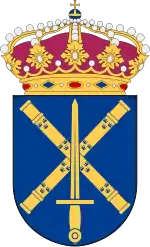Swedish Armed Forces Staff College
The [Royal] Swedish Armed Forces Staff College[note 1] (Swedish: Militärhögskolan, MHS) was from 1961 to 1996 the Swedish Armed Forces highest institution for officers training, for staff and senior executive education and was located in Stockholm. In 1997 it was merged with the Swedish National Defence College and formed the "new" Swedish National Defence College.
Militärhögskolan | |
 | |
| Type | Staff college |
|---|---|
| Active | 1961–1996 |
Parent institution | Swedish Armed Forces |
| Affiliation | Army, Navy, Air Force |
| Location | Valhallavägen 117, Stockholm |
| Language | Swedish |
| March | "Schlippenbachs marsch" (1964–1995)[1] "Generalfälttygmästaren" (1995–1996)[1] |
History

During the first part of the 20th century, the higher officer education was developed in the three military branches, the Army, Navy and Air Force. During the two world wars a variety of new weapons such as armor, air, gas, submarines and nuclear weapons were introduced.[3] Then came the Cold War, which contributed so that the higher officer training at the Royal Swedish Army Staff College, the Royal Swedish Naval Staff College and the Royal Swedish Air Force Staff College in 1961 were merged into a joint staff college, named the Royal Swedish Armed Forces Staff College.[3][4] The operations began on 1 October 1961 and the first instruction was established on 14 May 1964.[5] It organized compulsory general courses, often military branch targeted and aimed for captain positions, as well as higher volunteer staff courses and technical courses.[5]
In 1992 the military branch programmes were incorporated and then there were the following programmes: Tactical Program (TAKLI), Staff Program (SLI), Technical Program (TEKLI) and Operational Program (OPLI).[5] In 1994, the National School of Administration (Förvaltningshögskolan, FörvHS) was integrated with the Swedish Armed Forces Staff College, which became its own government agency. In 1995, parts of the Swedish National Defence Research Institute were transferred to the new Swedish Armed Forces Staff College. A special research area for security policy, strategy and military history was then established. In 1996, the government found that the link between civil and military defense had become increasingly important and, according to the government, there were strong reasons for the Swedish Armed Forces Staff College to merge with the Swedish National Defence College. The following year, the Swedish National Defence College and the Swedish Armed Forces Staff College were merged and formed the "new" Swedish National Defence College.[6]
The main part of the staff college was located at Valhallavägen 117 in Stockholm,[7] in the chancellery building and barracks of the old Svea Artillery Regiment (A 1).[8] Smaller units of the staff college were located in Östersund and Karlstad.[5]
Heads
- 1961–1974: Erik Rosengren
- 1974–1978: Gustaf Peyron
- 1978–1984: Nils-Fredrik Palmstierna
- 1984–1990: Evert Båge
- 1990–1996: Claes Tornberg
Names, designations and locations
| Name | Translation | From | To | |
|---|---|---|---|---|
| Kungl. Militärhögskolan | Royal Swedish Armed Forces Staff College | 1961-10-01 | – | 1974-12-31 |
| Militärhögskolan | Swedish Armed Forces Staff College | 1975-01-01 | – | 1996-12-31 |
| Designation | From | To | ||
| MHS | 1961-10-01 | – | 1996-12-31 | |
| Location | From | To | ||
| Stockholm Garrison | 1961-10-01 | – | 1996-12-31 |
Footnotes
- or the Royal Staff College of the [Swedish] Armed Forces.[2] The word "Royal" (Kungliga) was later removed.
References
- Stolt, Lars C. "MARCHE DE SLIPPENBACHE" [SLIPPENBACHE'S MARCH]. www.militarmusiksamfundet.com (in Swedish). Swedish Military Music Society. Retrieved 7 June 2017.
- Gullberg, Ingvar E. (1977). Svensk-engelsk fackordbok för näringsliv, förvaltning, undervisning och forskning [A Swedish-English dictionary of technical terms used in business, industry, administration, education and research] (in Swedish) (2nd ed.). Stockholm: Norstedt. p. 1479. ISBN 91-1-775052-0. SELIBR 8345587.
- Lindstedt, Anneli (2015-05-28). "Historik" [History] (in Swedish). Swedish Defence University. Retrieved 7 June 2017.
- Engström, Christer; Marklund, Kari, eds. (1994). "Militärhögskolan". Nationalencyklopedin: ett uppslagsverk på vetenskaplig grund utarbetat på initiativ av Statens kulturråd [Malay-Mönj] (in Swedish). Vol. 13. Höganäs: Bra böcker. p. 315. SELIBR 8211197.
- "Militärhögskolan > Förteckning" [Royal Swedish Armed Forces Staff College > List] (in Swedish). National Archives of Sweden. Retrieved 7 June 2017.
- "Från militär högskola till statlig högskola" [From military staff college to national university college] (in Swedish). Swedish Defence University. 2015-05-22. Archived from the original on 11 February 2011. Retrieved 7 June 2017.
- Sveriges statskalender. 1963 (in Swedish). Uppsala: Fritzes offentliga publikationer. 1963. p. 434.
- "ETT HISTORISKT OMRÅDE" [A HISTORICAL AREA] (PDF) (in Swedish). Vasakronan. p. 3. Retrieved 8 June 2017.
Further reading
- Kjellander, Bo, ed. (1986). Militärhögskolan och dess förhistoria: utgiven till Militärhögskolans 25-årsjubileum 1986 [Swedish Armed Forces Staff College and its prehistory: published at the 25th anniversary of the Swedish Armed Forces Staff College in 1986] (in Swedish). Stockholm: Probus. ISBN 91-87184-00-1. SELIBR 7762889.